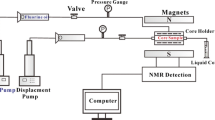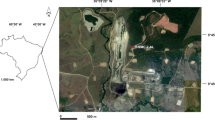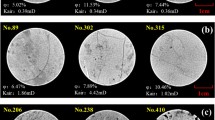Characterization of carbonate rocks may involve identifying the important pore types which are present. In the past, this task has required detailed petrographic analysis of many core samples. Here, we describe a method which uses nuclear magnetic resonance (NMR) measurements to reduce the amount of petrographic analysis needed for porosity typing of carbonate reservoir rocks.
For a rock sample which has been measured with NMR, our method decomposes the log(T2) spectrum into at most three Gaussian-shaped components and gives a set of nine parameters. Two characteristic quantities having geological significance are extracted from the nine parameters. Values of the two quantities are compared with a reference set, established from samples having both NMR and petrographic evaluations of porosity types. We use a Bayesian approach to the classification of the dominant porosity type.
Tests of our method on 103 samples show a correct prediction in 60 to 90 percent of the samples. The lower success rate was obtained for samples with five porosity types from three fields; the higher success rate obtained with samples with three porosity types from one well. The use of geologically significant quantities extracted from the decomposition gives comparable success rate to those obtained using a standard, non-geological approach such as canonical variates.


Similar content being viewed by others
References
Adams, A. J., 2005, Relationships between observed pore and pore-throat geometries, measured porosity and permeability, and indirect measures of pore volume by nuclear magnetic resonance: unpubl. doctoral dissertation, Texas A&M Univ., 277 p
Ahr, W. M., and Hammel, B. S., 1999, Identification and mapping of flow units in carbonate reservoirs: An example from the Happy Spraberry (Permian) Field, Garza County, Texas USA: Energy Exploration and Exploitation, v. 17, no. 3–4, p. 311–334
Ahr W. M., Allen D., Boyd A., Bachman H. N., Smithson T., Clerke E. A., Gzara K. B. M., Hassall J. K., Murty C. R. K., Zubari H., Ramamoorthy R., 2005, Confronting the carbonate conundrum: Schlumberger Oilfield Review, 17(1):18–29
Anselmetti F. S., Luthi S., Eberli G. P., 1998, Quantitative characterization of carbonate pore systems by digital image analysis: Am. Assoc. Petroleum Geologists Bull., 82(10):1815–1836
Ausbrooks, R., Hurley, N. F., May, A., and Neese, D.G., 1999, Pore-size distribution in vuggy carbonates from core images, NMR, and capillary pressure: Soc. Petroleum Engineers Paper 56506, p. 1–14
Bowers, M. C., Ehrlich, R., Howard, J. J., and Kenyon, W. E., 1993, Determination of porosity types from NMR data and their relationship to porosity types derived from thin section: Soc. Petroleum Engineers Paper 26307, p. l–46
Bui, T. D., Jensen, J. L., and Hanks, C. L, 2007, Neural network modeling with sparse datasets: Petroleum Science and Technology, in press
Chang C., Vinegar H., Morriss C., Staley C., 1997, Effective porosity, producible fluid, and permeability in carbonates from NMR logging. The Log Analyst, 38(2):60–72
Coates G. R., Xiao L., Prammer M. G., 1999, NMR logging principles and applications: Halliburton Energy Services, Houston, p. 233
Genty, C., 2006, Distinguishing carbonate reservoir pore facies with nuclear magnetic resonance as an aid to identify candidates for acid stimulation: unpubl. masters thesis, Texas A&M Univ., 97 p
Henderson S., 2004, Nuclear magnetic resonance logging, in Asquith, G., and Krygowski, D., eds., Basic Well Log Analysis: Am. Assoc. Petroleum Geology Methods in Exploration 16, p. 103–113
Hidajat I., Mohanty K. X., Flaum M., Hirasaki G., 2004, Study of vuggy carbonates using NMR and X-ray CT scanning: Society of Petroleum Engineers Reservoir Evaluation & Engineering, 7(5):365–377
Kenyon W. E., 1997, Petrophysical principles of applications of NMR logging: The Log Analyst, 38(2):21–43
Kenyon, W. E., Takezaki, H., Straley, C., Sen, P. N., Herron, M., Matteson, A., and Petricola, M. J., 1995, A laboratory study of nuclear magnetic resonance relaxation and its relation to depositional texture and petrophysical properties – Carbonate Thamama Group, Mubarraz Field, Abu Dhabi: Soc. Petroleum Engineers Paper 29886, p. 477–502
Krzanowski W. J., 2000, Principles of multivariate analysis: A user’s perspective (revised edn.): Oxford Univ. Press, New York, p 586
Lodola, D., 2004, Identification of pore type and origin in a Lower Cretaceous carbonate reservoir using NMR T 2 relaxation times: unpubl. masters thesis, Texas A&M Univ., 67 p
Parra, J. O., Hackert, C. L., and Wilson, L. L., 2002, A methodology to integrate magnetic resonance and acoustic measurements for reservoir characterization: Rept. DE-AC26-99BC15203, Southwest Research Institute, Department of Energy, San Antonio, Texas, 147 p
Acknowledgements
This project was partly funded by the Stimulation in Middle East Carbonates Program at Texas A&M University. CG thanks the IAMG for the student grant for the year 2005–2006. We thank the reviewers for suggesting improvements.
Author information
Authors and Affiliations
Corresponding author
Rights and permissions
About this article
Cite this article
Genty, C., Jensen, J.L. & Ahr, W.M. Distinguishing Carbonate Reservoir Pore Facies with Nuclear Magnetic Resonance Measurements. Nat Resour Res 16, 45–54 (2007). https://doi.org/10.1007/s11053-007-9035-8
Received:
Accepted:
Published:
Issue Date:
DOI: https://doi.org/10.1007/s11053-007-9035-8




